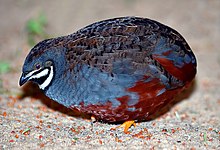King quail
| King quail | |
|---|---|
 |
|
| Scientific classification | |
| Kingdom: | Animalia |
| Phylum: | Chordata |
| Class: | Aves |
| Order: | Galliformes |
| Family: | Phasianidae |
| Subfamily: | Perdicinae |
| Genus: | Excalfactoria |
| Species: | E. chinensis |
| Binomial name | |
|
Excalfactoria chinensis (Linnaeus, 1766) |
|
| Synonyms | |
|
|
The king quail (Excalfactoria chinensis), also known as the blue-breasted quail, Asian blue quail, button quail, Chinese painted quail, or Chung-Chi, is a species of Old World quail in the family Phasianidae. This species is the smallest "true quail" and is quite common in aviculture worldwide. In the wild they range from southeastern Asia to Oceania with 10 different subspecies.
A failed attempt was made to introduce this species to New Zealand by the Otago Acclimatisation Society in the late 1890s.
The male king quail comes in many colors, including blue, brown, silver, maroon, dark brown & almost black. They have orange feet which are hard and able to withstand a continuous life on the ground like many other game birds.The female is similar to the male but cannot come in shades of blue. They can live up to 13 years in captivity but only 3-6 on average. In the wild they may live only 1.5 years. The eggs of king quail are a light, creamy-brown colour and slightly pointed at the 'top'; roughly ovular in shape.
There are nine recognized subspecies:
Clutch size varies anywhere from 5 to 13 eggs. Before incubation starts all the eggs composing the clutch will be laid. In captivity, if the female lays too many eggs, they should be taken, as after about 10 days they go cold and die. In captivity, the ideal number of eggs in a clutch is 6 to 8. The chicks hatch after about 19 days.
King quail are not listed as threatened on the Australian Environment Protection and Biodiversity Conservation Act 1999.
This species is listed as threatened on the Victorian Flora and Fauna Guarantee Act (1988). Under this Act, an Action Statement for the recovery and future management of this species has not been prepared.
On the 2007 advisory list of threatened vertebrate fauna in Victoria, this species is listed as endangered.
This quail has been very popular to keep and breed for many years; numerous mutations have been developed. They are quite hardy once they have adjusted to their surroundings and will keep the bottom of an aviary spotless. Yet these small quails are more than just effective scavengers. They provide colour, & charm to a part of the aviary that otherwise may not be used, & their breeding behavior is fascinating, especially the development of their chicks. A great advantage of these quails is that they will live exclusively on the ground, & will not interfere with other birds. The cost of purchasing and maintaining them is very little. These quails take only a small amount of time to feed and water and, in some cases, they have been known to become hand-tame.
...
Wikipedia

